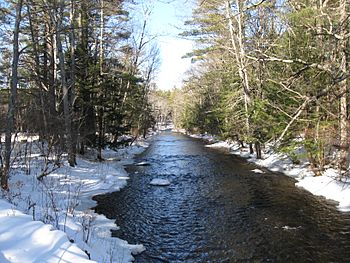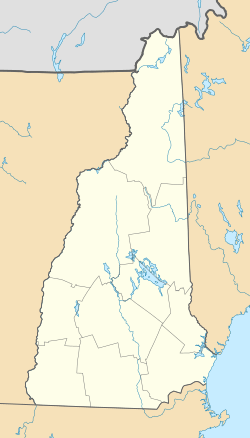Middle Branch Piscataquog River facts for kids
Quick facts for kids Middle Branch Piscataquog River |
|
|---|---|

The Middle Branch near its mouth
|
|
| Country | United States |
| State | New Hampshire |
| County | Hillsborough |
| Towns | Francestown, New Boston, Weare |
| Physical characteristics | |
| Main source | Haunted Lake Francestown 635 ft (194 m) 42°59′18″N 71°45′34″W / 42.98833°N 71.75944°W |
| River mouth | South Branch Piscataquog River New Boston 335 ft (102 m) 43°0′3″N 71°39′39″W / 43.00083°N 71.66083°W |
| Length | 10.6 mi (17.1 km) |
| Basin features | |
| Tributaries |
|
The Middle Branch of the Piscataquog River is a river in southern New Hampshire, United States. It flows for about 10.6 miles (17.1 kilometers). This river is a smaller stream that flows into a larger one. It is part of the Merrimack River system. This means its water eventually joins the Merrimack River.
Contents
About the Middle Branch Piscataquog River
The Middle Branch Piscataquog River is an important waterway. It helps carry water from the land to larger rivers. This river is located in Hillsborough County. It flows through several towns in New Hampshire. These towns include Francestown, New Boston, and Weare.
Where Does the River Start?
Every river has a beginning, called its source. The Middle Branch Piscataquog River starts at a place called Haunted Lake. This lake is in the eastern part of Francestown. The water from the lake flows out and becomes the river.
The River's Journey
From Haunted Lake, the river begins its journey. It flows mostly towards the east-northeast. It passes through the town of New Boston. Then, it enters the town of Weare. In Weare, the river makes a sharp turn. It changes direction and flows south. After this turn, it goes back into New Boston. Finally, it joins another river. This river is called the South Branch Piscataquog River. When two rivers join, the smaller one is called a tributary.
Why Rivers Are Important
Rivers like the Middle Branch Piscataquog are very important. They provide homes for many plants and animals. Fish, insects, and birds all depend on rivers. Rivers also help move water across the land. This water can be used for drinking, farming, and other activities. They are a vital part of our natural world.



